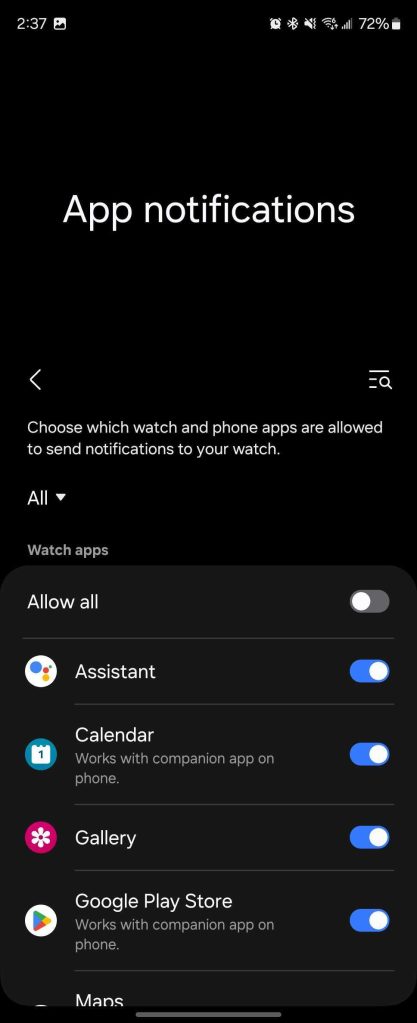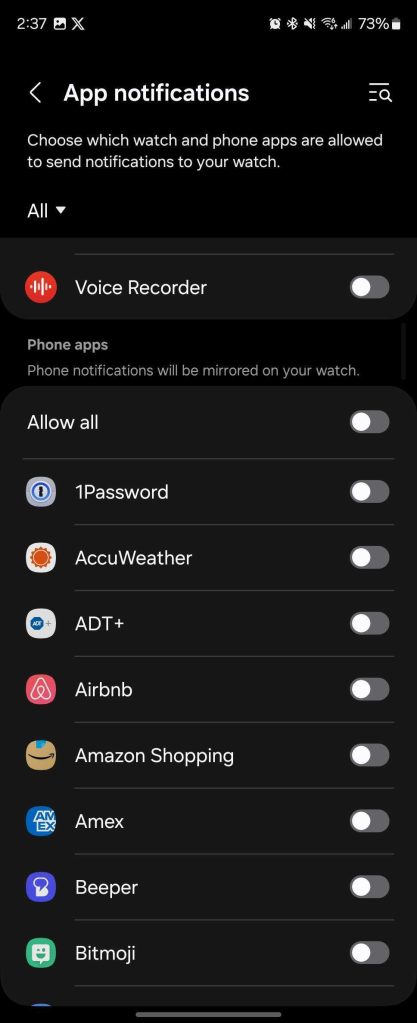
Years into Samsung’s Galaxy Watch series, there’s still one aspect of the software that rubs me the wrong way, and it’s how Samsung chooses to handle notifications – by turning the vast majority of them off by default.
One of the core reasons to buy a smartwatch is to have a quick and easy way to see notifications from your wrist. That quick preview lets you take faster action, or decide on whether or not you even need to act in a way that won’t stop you from what you’re already doing.
Whether it’s Wear OS or the now-dead Tizen, Samsung smartwatches have long supported the ability to turn on or off notifications for a specific app on a phone. That’s a core feature of pretty much any smartwatch, really, and it makes complete sense to have the option.
But what’s always been really annoying for me is that Samsung opts to disable notifications on Galaxy Watch out of the box. Only a handful of apps are supported by default even on the latest Galaxy Watch 7. Setting the device up from scratch on a Galaxy Z Fold 6, I was presented with only the following apps with notifications enabled:
- Assistant
- Calendar
- Gallery
- Google Play Store
- Google Maps
- Google Messages
- Samsung Messages (weirdly even if your phone doesn’t have it)
- Reminder
By default, that’s all you get. That means you don’t get notifications for emails, for your smart home, or for really anything else.
That’s a terrible experience!
It’s easy enough to change this in the Samsung Galaxy Wearable app (Watch settings > Notifications > App notifications), but the average user might not know to do that right away. And Samsung’s setup process doesn’t make this clear at all (or, if it does, it’s clearly not well spelled out).
Contrary to Samsung’s choice here, Wear OS itself actually just lets any app on your phone send notifications to the watch. If an app sends notifications you don’t want, you can then go into the companion app and turn that off going forward.



9to5Google’s Take
Why does Samsung disable most notifications out of the gate?
There’s no official reasoning, but I’ve got two ideas.
Top comment by Will
I'd rather turn on the ones I want than have to turn off all the ones I don't. I don't want my wrist buzzing for every single pointless notification that an app thinks I need. I curate my notifications to what I care about and it's much easier to select the ones you want than try to go through the whole list to disable the ones you don't.
The first is for the sake of battery life. If you restrict how many apps can send notifications, thereby lighting up the display and buzzing your wrist, battery life gets better by way of the user simply not using the watch as often. The second is for simplification. If your watch doesn’t get every notification, the experience of using it is less “in the way.”
Personally, I think both arguments are fine, but I strongly feel this should be opt-in behavior. As it stands today, there’s no quick and easy way for a user to know why the notification on their phone isn’t showing up on their Galaxy Watch, and that’s sure to be frustrating.
What do you think?
More on Galaxy Watch:
- Who is the Galaxy Watch Ultra actually for?
- The $5,650 timepiece that Samsung’s Galaxy Watch Ultra looks like
- Galaxy Watch 7 and Ultra no longer support wireless charging from your phone
Follow Ben: Twitter/X, Threads, Bluesky, and Instagram
FTC: We use income earning auto affiliate links. More.




Comments